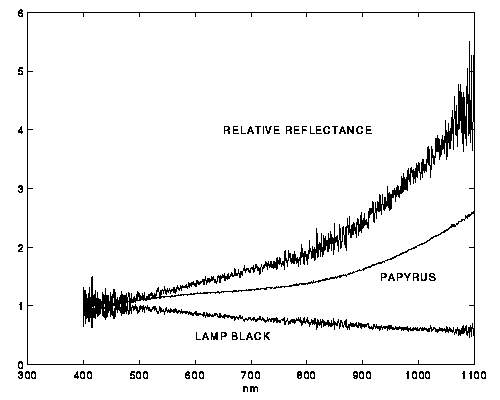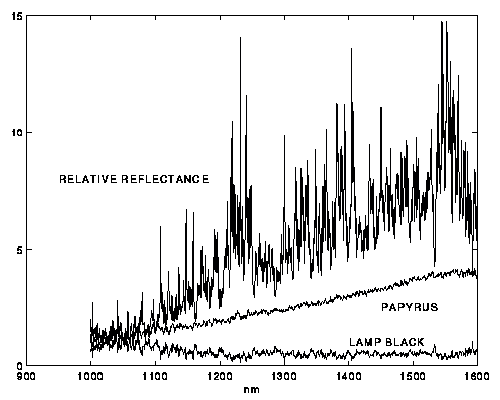Measurements
The contrast between the characters and the papyrus background varies
depending on the wavelentgh of light. By contrast we mean the ratio
between the reflectivities within the chosen spectral band.
In blue light, black text upon red background would produce black text
and dark background, characters being difficult to read. In red
light, the background would be bright while the characters would
remain dark, meaning much better contrast. If there is an optimal
spectral band for the papyrus writings, that should be used.
The spectra of the papyrus background and lampblack (carbon black)
were measured using Monolight Instrument's [xx]. Direct measurement
of the ink with the instruments at hand wouldn't have been
reliable due to the thinness of the characters; parts from the
background would inevitably have been included in the measurements.
Insteadt, we used self-produced lampblack substitute.
Lampblack can be produced in small quantities
simply by the ancient method of burning a candle and collecting
the carbon from the flame onto a surface, in this case, onto a
surface of a small 2x5 cm microscope glass plate. Measuring
the spectra from the small plate is quite easy. The ink in
carbonized papyrus has only its lampblack pigment left, so our
substitute should give quite reliable results.
Figure [6] shows the relative reflectances of the papyrus
background and the lampblack within 400-1100nm, measured using
a silicon detector. A germanium detector was used to measure
the reflectances in the 800-1500nm band in figure [7].
The raw spectra were normalized to one at 400nm (fig. [6])
and 1000nm (fig. [7]). The differences in absolute intensity
values were big, the reflected intensity of the background
being tenfold compared to the lampblack. The absolute values
are not presented here, as the relative reflectance is a
better measure of contrast differences as a function of wavelength.
Because the reflectance of lampblack is nearly zero in
wavelengths over 1000nm, measurement of the relative reflectance
becomes very noisy. The Ge detector used in that area is
also less sensitive than the Si-detector, so the overall
noise is larger, although the spectra of figure [7] were
gathered over a longer period of time.
The overall impression of the relative reflectance at wavelengths
400-1600nm is clear: at longer wavelengths, the papyrus
background reflects relatively more than the script. Therefore,
the contrast should be better at longer wavelengths.
We should be able detect
the effect at 750nm with red-extended films, and it should be
clearly visible around 1000nm, at the limits of our CCD camera.
These observations concern only the measured bandwidth.
The absorption of IR radiation by the glass plate will cause
noteworthy alteration to spectra in longer than 2000nm
wavelengths.

Figure 5:
Reflectances at 400-1100nm, Si-detector
 Figure 6:
Reflectances at 1000-1600nm, Ge-detector
Figure 6:
Reflectances at 1000-1600nm, Ge-detector
 Back to Previous Work
Back to Previous Work
 Back to Contents
Back to Contents
 Next: Recording
Next: Recording
Antti Nurminen, 34044T, andy@cs.hut.fi

 Figure 6:
Reflectances at 1000-1600nm, Ge-detector
Figure 6:
Reflectances at 1000-1600nm, Ge-detector